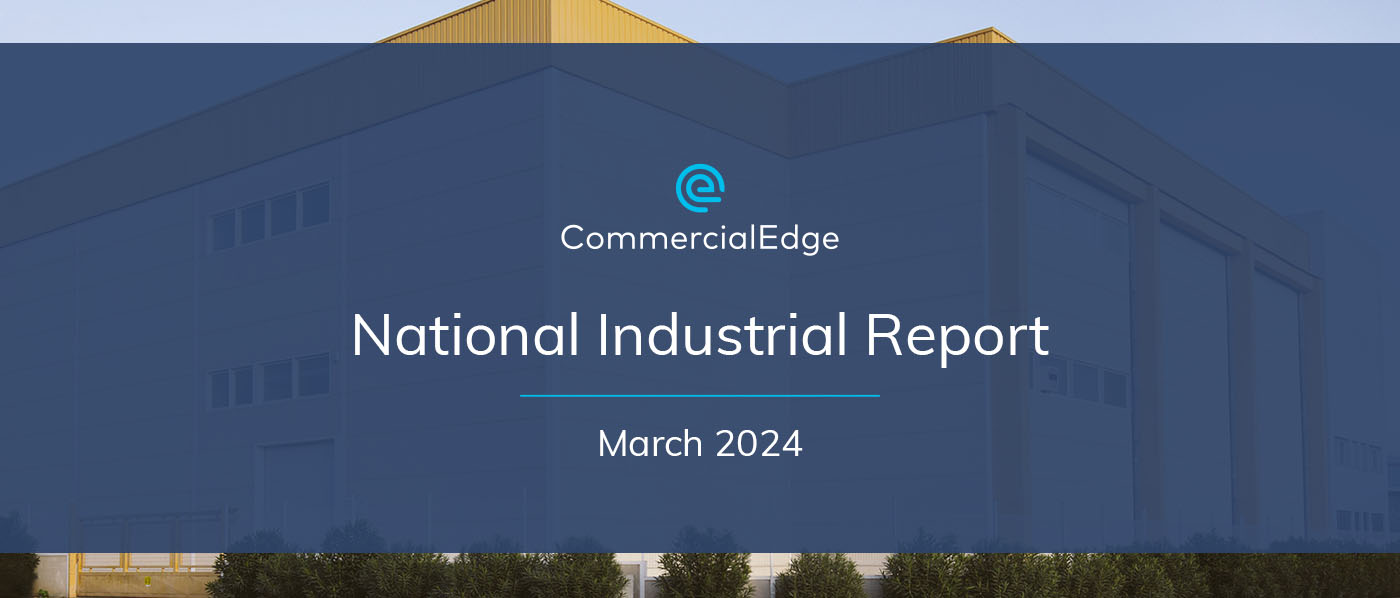Key Takeaways:
- National industrial in-place rents averaged $7.68 per square foot in February, up 7.5% year-over-year
- The national vacancy rate stood at 5.0%, up 20 basis points month-over-month
- Nationwide, nearly 420 million square feet of industrial space were under construction
- Industrial transactions totaled $5.7 billion through February, at an average sale price of $132 per square foot
- The Inland Empire saw the highest rent growth nationwide, with average rents up 12.7% year-over-year in February
- Phoenix had the most significant development pipeline, encompassing 42.7 million square feet
- Orange County had the highest in-place rents for industrial space, averaging $15.29 per square foot
- Los Angeles recorded the largest sales volume, reaching $435 million in the first two months of the year
Artificial intelligence has witnessed a significant surge in growth during the past year. The technology’s resource-intensive nature requires vast data and processing power, naturally leading to a rise in demand for data centers, our latest U.S. industrial market report reveals.
In the 120 markets covered by CommercialEdge, there are currently 27.4 million square feet of data center space under construction, and an additional 33.5 million square feet are in the planning stages.
“While recognized as a niche subset of the market, it is a notable opportunity in certain markets as general warehouse/distribution project starts continue to slow.”
Peter Kolaczynski, Director, CommercialEdge
And, despite a slowdown in overall industrial starts, data centers are on the rise. In 2023, data center starts increased to 14.2 million square feet from an average of 10 million square feet annually in the previous three years. The share of data centers in all industrial starts grew from 2.0% between 2020 and 2022 to 4.3% in 2023. This, in turn, has led to some construction shifting to secondary and tertiary markets.
Washington, D.C., is home to the largest data center market in the U.S., with most facilities concentrated in Northern Virginia. The market’s existing infrastructure provides an advantage over other locations.
However, there are concerns about Northern Virginia’s ability to add more data centers due to the high power consumption required by these facilities — an estimated two to five times more energy than a typical cloud server. Since AI model training requires power-hungry GPUs, data center operators are exploring other regions, such as the West, or secondary markets like Atlanta, which has 3 million square feet of data center space underway, equal to 34% of existing stock.
Rents and Occupancy: Coastal Markets Continue to Lead U.S. Rent Growth
National in-place rents for industrial space averaged $7.68 per square foot in February, a decrease of four cents from January but up 7.5% year-over-year. The average rate for new leases signed in the last 12 months rose to $10.31 per square foot in February — $2.63 more than the average for all leases. The highest spread between the rates for new leases and existing rates was in coastal markets.
Average Rent by Metro
While in-place rent growth was highest in the Inland Empire — up 12.7% year-over-year as of February — three other coastal markets also exceeded the 10% year-over-year growth: Miami (12.0%), Orange County (11.4%), and Los Angeles (11.4%).
The national industrial vacancy rate was 5.0% in February, up 20 basis points from the previous month. While vacancies have slightly increased due to demand cooling as record levels of new supply came online, this has provided some much-needed relief to the most sought-after markets.
Supply: Phoenix Pipeline Large but New Starts Slow Down
Nationally, industrial supply under construction currently totals 419.8 million square feet, representing 2.2% of stock, according to our latest U.S. industrial market report. Increased interest rates, tightened standards for construction loans, normalizing demand for industrial space and economic uncertainty have combined to cool the industrial pipeline, which reached record levels in 2021 and 2022.
National Industrial Supply Pipeline Trend (Million Sq. Ft.)
New construction starts fell more than 40% between 2022 and 2023, with 341.9 million square feet breaking ground last year. The pipeline deceleration has continued in the early stages of 2024, with our database logging only 20 million square feet of starts during the first two months of this year. While there is a lag in collecting all starts data, this is a significant slowdown from previous quarters.
Phoenix continues to be the most active U.S. market for industrial construction, with 42.7 million square feet underway (11.1% of stock — the highest nationwide). Last April, the Phoenix pipeline reached 57.6 million square feet under construction, its largest size ever recorded by our database. In the months since, Phoenix has logged 29.1 million square feet of completions, with just 14.1 million started.
Transactions: Average Sale Prices Remain Competitive
Nationwide, industrial sales totaled $5.7 billion in the first two months of 2024, with properties trading at an average of $132 per square foot, the latest U.S. industrial market report shows.
Despite the decline in sales over recent quarters, the average sale price of industrial properties has remained high, increasing by 9.6% quarter-over-quarter and 2.0% year-over-year. Factors mentioned earlier, including higher interest rates, tightened capital markets and normalizing demand, have not resulted in discounts in the industrial property market.
2024 Year-to-Date Sales (Millions)
Los Angeles led the nation in sales volume, with transactions here totaling $435 million. Investor interest in Los Angeles properties remains elevated, but price appreciation has leveled off following a period of rapid growth. Between 2019 and 2021, the average sale price in Los Angeles climbed 44.7% from $190 to $294 per foot. The average sale price rose only 8.9% in the years since, resting at $320 per foot in 2024.
Western Markets: Orange County In-Place Rents Highest in the Nation
Western regions maintained their status as the priciest in the U.S. for industrial rents. Orange County topped the list with $15.29 per square foot, Los Angeles followed with $14.14, and Seattle logged $10.94. While rents in most Western markets surpassed the national average of $7.68 per square foot, these were the only ones with double-digit rental rates. The Central Valley, with $6.15 per square foot, stood out as the only Western market with listing rates below the national average.
In-place rent growth was highest in the Inland Empire, where it increased 12.7% year-over-year. The market has been at the top of the rent growth metric since we began reporting rents at the start of 2021. Notably, in-place rents in the Inland Empire swelled more than 60% during that time.
The only other markets in the region to see double-digit in-place rent growth were Los Angeles and Orange County, both at 11.4% as of February, according to the most recent industrial property market report.
West Regional Highlights
The average rate for new leases signed in the last 12 months was highest in Orange County ($19.64 per square foot), Los Angeles ($19.37), the Bay Area ($18.27), and the Inland Empire ($15.01). Outside of California, the only markets where the average rate for new leases signed outpaced the national figure were Seattle ($13.79 per square foot), Portland ($11.11), and Phoenix ($11.03).
The Inland Empire is finally showing signs of a cooldown, with industrial vacancy rates at 6.0% in February of this year, after sitting below 3% — at times even below 2% — during most of the previous three years. To meet booming demand, developers rushed to bring new space to the Inland Empire and delivered 100 million square feet (16.2% of stock) since the start of 2020.
With 42.7 million square feet underway, Phoenix continues to be the most active U.S. market for industrial development. Furthermore, Phoenix had the lowest vacancy rate among Western markets — 3.2% as of February — followed by Portland (4.1%), Orange County (4.5%), and the Bay Area (4.6%).
The largest sales volume ($435 million) and the highest average sales price ($320 per square foot) were recorded in Los Angeles during the first two months of 2024. The Bay Area had the third-largest deal volume in the U.S. ($321 million). Meanwhile, Phoenix ($298 million), Denver ($240 million), Seattle ($176 million), and the Inland Empire ($143 million) were among the major markets to surpass the $100-million threshold, this month’s industrial property market report reveals.
Midwestern Markets: Kansas City Vacancy Rate Still Lowest Nationwide
Continuing trends observed in previous months, Kansas City maintained its position as the tightest industrial market in the nation, with only 2.5% of space available for lease at the end of February. While demand remained strong, rent growth was slower in Kansas City compared to port markets. In-place rents here rose 4.7% year-over-year to $4.89 per square foot, while the average for new leases signed over the past 12 months was slightly higher, at $5.60 per square foot.
As a pivotal hub for industrial and logistics activities in the U.S., Kansas City offers access to 90% of the country within a two-day drive, thanks to its central location. Due to its strong infrastructure, strategic placement and economic incentives, the market is an essential logistics center for automotive suppliers and third-party logistics providers (3PLs), according to CBRE.
Midwest Regional Highlights
Columbus was the next-tightest industrial market in the U.S., with its vacancy rate at 2.7% at the end of February. The Ohio logistics hub also recorded the most notable rent growth in the Midwest, with in-place rents increasing 6.7% year-over-year to $4.64 per square foot.
While new leases signed over the past 12 months in Columbus yielded the most significant lease premiums in the region at $2.77 per square foot, new leases were the priciest in Minneapolis-St. Paul ($7.84 per square foot).
Overall, all Midwestern markets recorded asking rents below the national average of $7.68 per square foot. Detroit ($6.79 per square foot) and the Twin Cities ($6.77 per square foot) came the closest to the national figure. St. Louis ($6.06 per square foot) and Chicago ($6.00 per square foot) were the only other Midwestern markets to exceed the $6 per-square-foot average, according to our industrial property market report.
While Chicago had the largest pipeline in the Midwest in terms of volume as of February, with 11.4 million square feet underway, Kansas City has consistently led the region in construction on a percentage-of-stock basis. As of February, the metro had 11.3 million square feet of space in development, equal to 4.1% of its existing inventory.
Meanwhile, Chicago recorded the largest sales volume in the Midwest and the second-largest nationwide, with industrial sales amounting to $373 million in February. Columbus followed with the second-largest volume in the region, closing deals worth $123 million. Regarding sale prices, the Twin Cities was the only Midwestern market with an average sale price above the $100 per-square-foot mark, at $123 per square foot.
Southern Markets: Dallas-Fort Worth Pipeline Is Second Largest in the U.S.
Maintaining its solid listing growth performance, Miami had the second-highest year-over-year rent increase among leading Southern industrial markets. With a growth rate of 12.0%, in-place rents reached $11.18 in Miami as of February.
While no other Southern market outperformed the national average of $7.68 per square foot, Tampa came close with an average of $7.37 per square foot, followed by Charlotte ($6.57) and Houston ($6.56). And with rents rising by 7.8% as of February, Nashville was the only market other than Miami to surpass the national rate of 7.5%.
South Regional Highlights
Miami also led the South in terms of lease premiums — new leases inked here over the last 12 months averaged $16.32 per square foot, bringing lease spreads to $5.14 per square foot. Nashville had the next highest premiums at $3.63 per square foot, followed by Atlanta ($2.89) and Tampa ($2.62).
Although below the national growth rate, Atlanta’s year-over-year rate of 7.1% placed the metro among the leading Southern markets. Rents in Dallas-Fort Worth also rose by 7.1% over the same period.
The Dallas-Fort Worth Metroplex led industrial construction in the region in terms of square footage. With 27.2 million square feet of space underway as of February (equal to 2.9% of stock), the market’s pipeline was the second-largest nationwide, the latest U.S. industrial market report reveals.
Charlotte led development in the South on a percentage-of-stock basis, with projects underway accounting for 4.1% of existing inventory. The market’s 13-million-square-foot construction pipeline was the second largest in the region, followed by Houston’s 8.2 million square feet and Atlanta’s 5.7 million square feet underway.
So far, Dallas-Fort Worth has logged the largest sales volume in the region — $318 million — and the fourth largest in the nation. Properties here traded at an average of $165 per square foot. Next, Houston industrial sales totaled $220 million through February, at an average of $124 per square foot. Atlanta also exceeded the $100-million mark, recording deals worth $168 million at an average of $118 per square foot.
Northeastern Markets: New Jersey Claims Highest Average Sale Price in the Region
In the Northeast, nearly every market tracked by our database posted listing rates above the national average. New Jersey led the region with $10.38 per square foot as of February. Boston followed with an average of $10.35 per square foot, Bridgeport with $8.98, and Baltimore with $7.74. Philadelphia was the only Northeastern market with rents below but not far behind the national average, at $7.49 per square foot.
New Jersey was also in the lead in terms of rent growth, with rents here increasing 9.1% year-over-year through February. Boston was the only other market to surpass the national figure, with an 8.4% increase year-over-year.
Northeast Regional Highlights
The most considerable lease spreads in the Northeast were recorded in New Jersey ($3.62 more per square foot), followed by Bridgeport ($3.06) and Philadelphia ($2.66).
When it comes to industrial vacancy rates, only two markets posted rates below the 5.0% national average. Specifically, Bridgeport had a vacancy rate of 3.7%, while New Jersey’s was much closer to the national figure, at 4.7% as of February.
New Jersey led the Northeast regarding new supply, with 7.1 million square feet of industrial space underway, representing 1.2% of total stock. Philadelphia followed with 6.2 million square feet in development (1.4% of stock). Meanwhile, Baltimore had the smallest construction pipeline in the region, comprising 787,875 square feet of industrial space, equal to 0.4% of local inventory.
Consistent with trends observed in previous industrial real estate market reports, New Jersey recorded the largest sales volume across leading Northeastern markets, with transactions here totaling $171 million. The market also claimed the region’s highest sale price, as properties sold at an average of $249 per square foot. Boston also logged notable sales in the first two months of 2024, with total transactions amounting to $107 million, at an average of $234 per square foot.
Economic Indicators: E-commerce Sales Growth Cools
Online sales growth cooled in the fourth quarter of 2023, according to the U.S. Census Bureau. On a seasonally adjusted basis, e-commerce sales totaled $285.2 billion in the fourth quarter of 2023, up 0.8% from the previous quarter and 7.5% year-over-year. This was the lowest quarterly increase of the year and only the third quarter since 2010 to grow less than 1% (the others were the fourth quarter of 2022 and the third quarter of 2021). Despite the fourth-quarter slowdown, e-commerce sales totaled $1.1 trillion in 2023, up 7.4% from 2022.
The downturn in warehouse jobs coincided with Amazon scaling back its expansive growth during the pandemic. This included offering millions of square feet of space for sublease and postponing the completion of some construction projects. Given that Amazon is a major employer in this sector, its decision to sublease more space in November suggests that a significant rebound in warehouse employment is unlikely in the near future.
Download the complete March 2024 report for a full picture of how U.S. industrial markets evolved in February, including insights on industry indicators and economic recovery fundamentals.

You can also see our previous industrial reports.
Methodology
The monthly CommercialEdge national industrial real estate report considers data recorded throughout the course of 12 months and tracks top U.S. industrial markets with a focus on average rents; vacancies (including subleases but excluding owner-occupied properties); deals closed; pipeline yield; forecasts; and the economic indicators most relevant to the performance of the industrial sector.
CommercialEdge collects listing rate and occupancy data using proprietary methods.
- Average Rents —Provided by Yardi Market Expert, a cutting-edge service that uses anonymized and aggregated data from other Yardi platforms to provide the most accurate rental and expense information available.
- Vacancy — The total square feet vacant in a market, including subleases, divided by the total square feet of industrial space in that market. Owner-occupied buildings are not included in vacancy calculations.
Stage of the supply pipeline:
- Planned — Buildings that are currently in the process of acquiring zoning approval and permits but have not yet begun construction.
- Under Construction — Buildings for which construction and excavation has begun.
Sales volume and price-per-square-foot calculations for portfolio transactions or those with unpublished dollar values are estimated using sales comps based on similar sales in the market and submarket, use type, location and asset ratings, sale date and property size.
Year-to-date metrics and data include the time period between January 1 of the current year through the month prior to publishing the report.
Market boundaries in the CommercialEdge industrial report coincide with the ones defined by the CommercialEdge Markets Map and may differ from regional boundaries defined by other sources.
Stay current with the latest market reports and CRE news:
Latest Posts
Recent Reports
Tariff Uncertainty Brings Short-Term Disruptions to Industrial Sector
Tariff uncertainty will lead to delayed leasing decisions from industrial occupiers, while also increasing construction costs
Coworking Continues to Gain Traction Amid Shifting Market Dynamics
Coworking spaces across the nation continue to grow in numbers and popularity, bringing more options to the office sector amid ongoing shifts.
Manufacturing Growth Set to Fuel Industrial Space Demand
The manufacturing sector is expected to remain a key driver of industrial development, though not without challenges.







